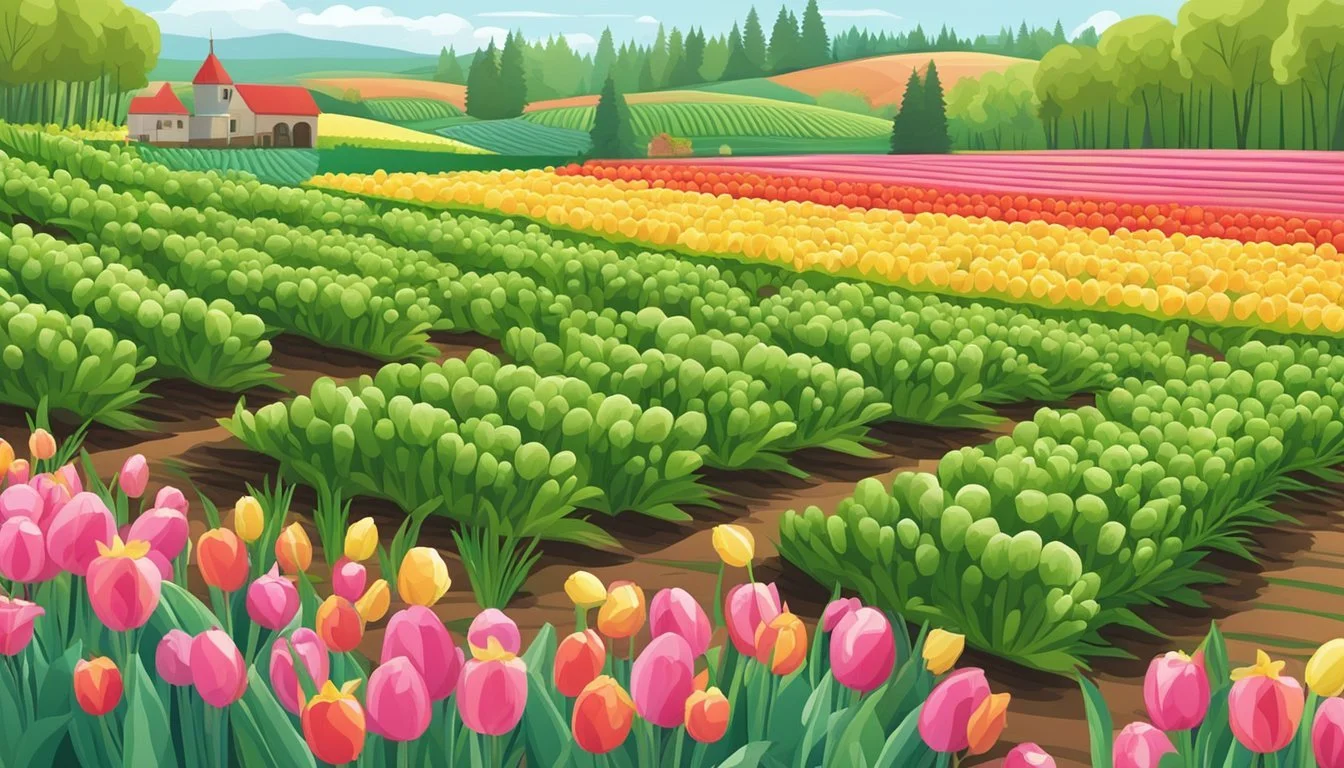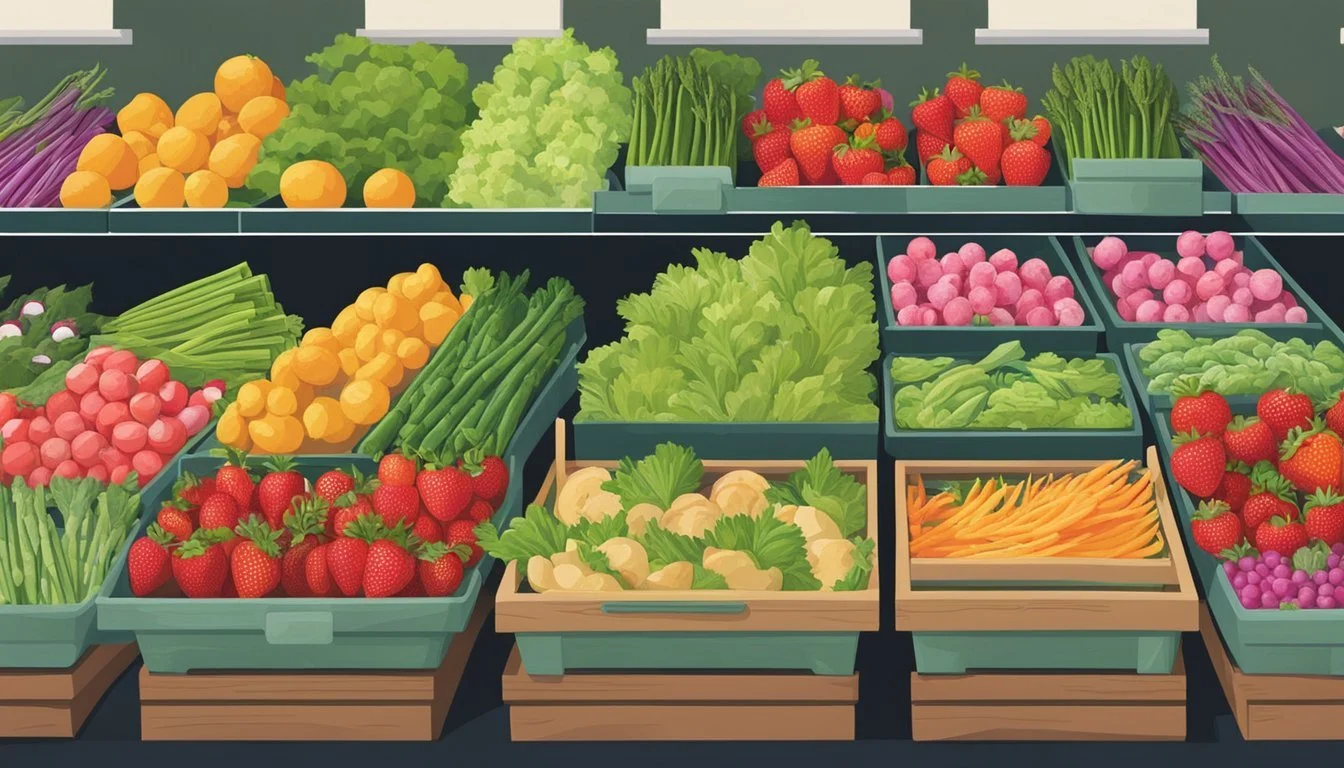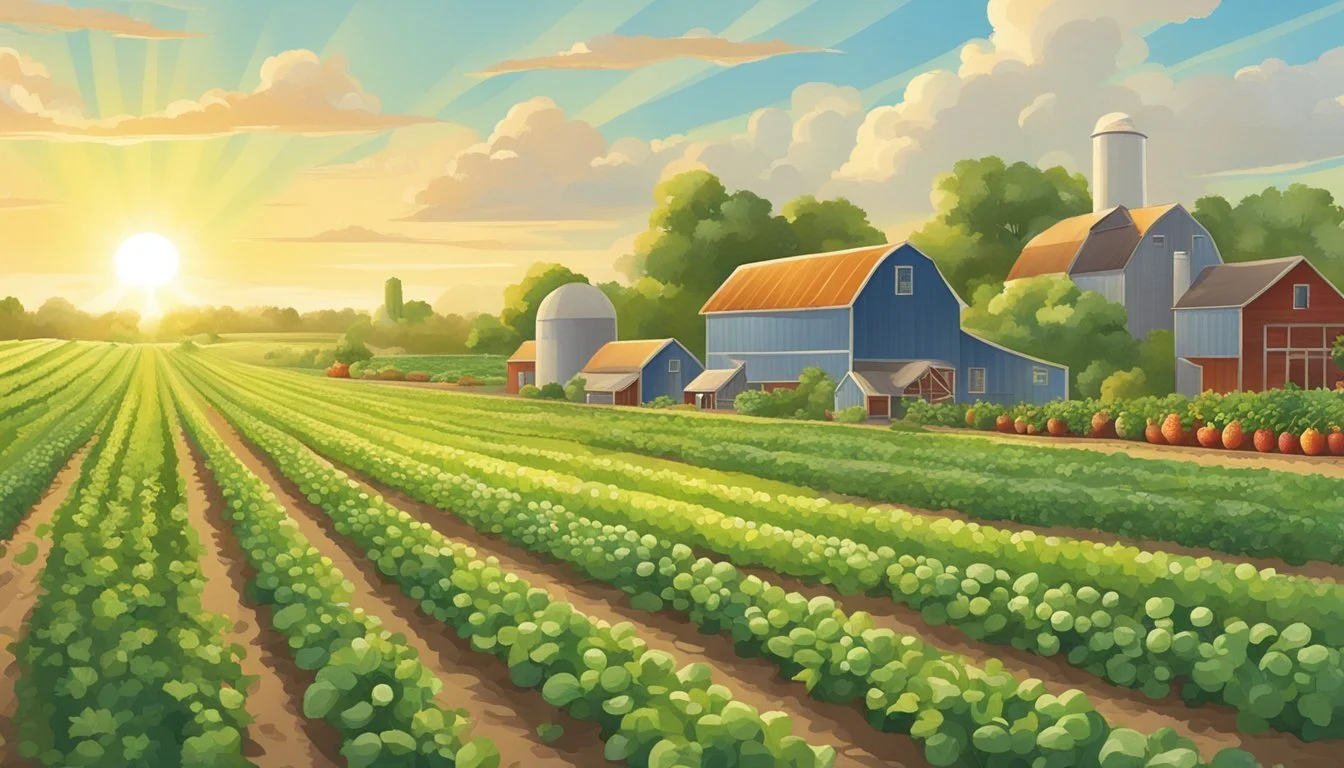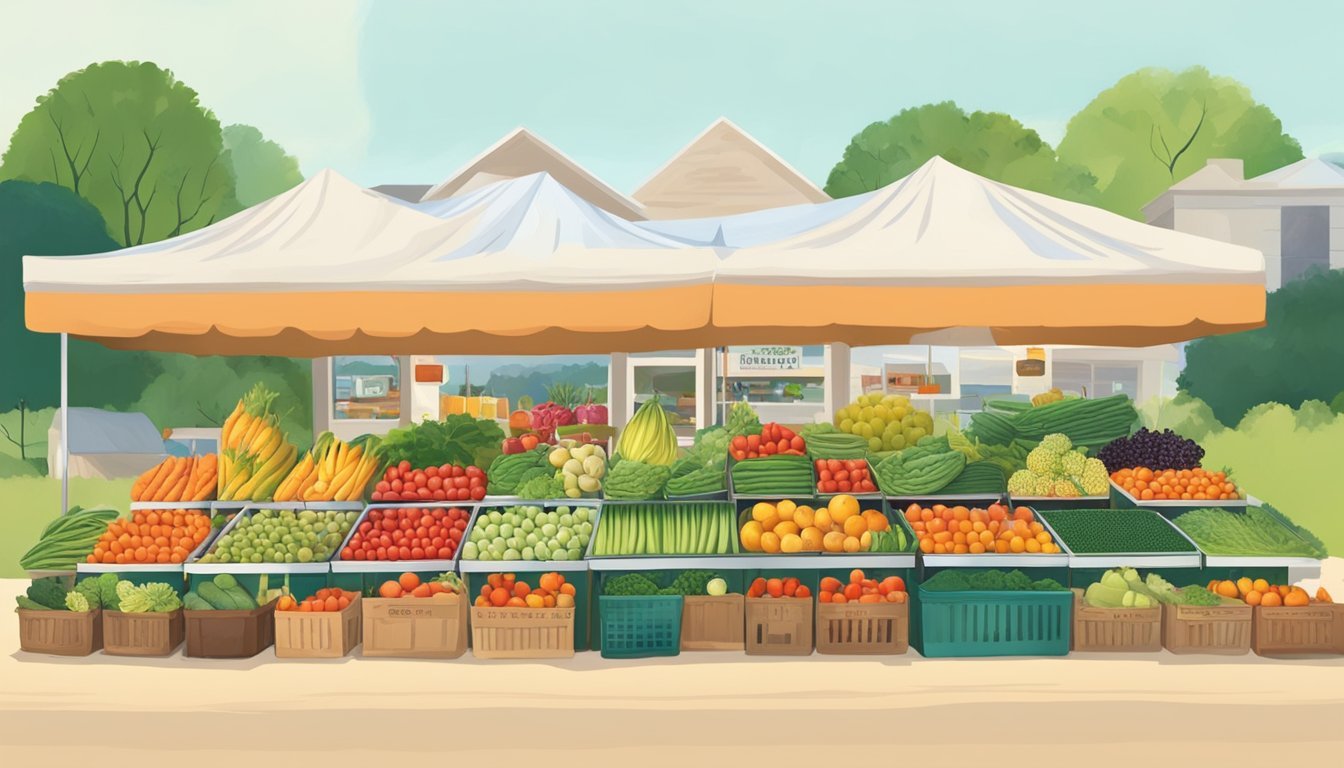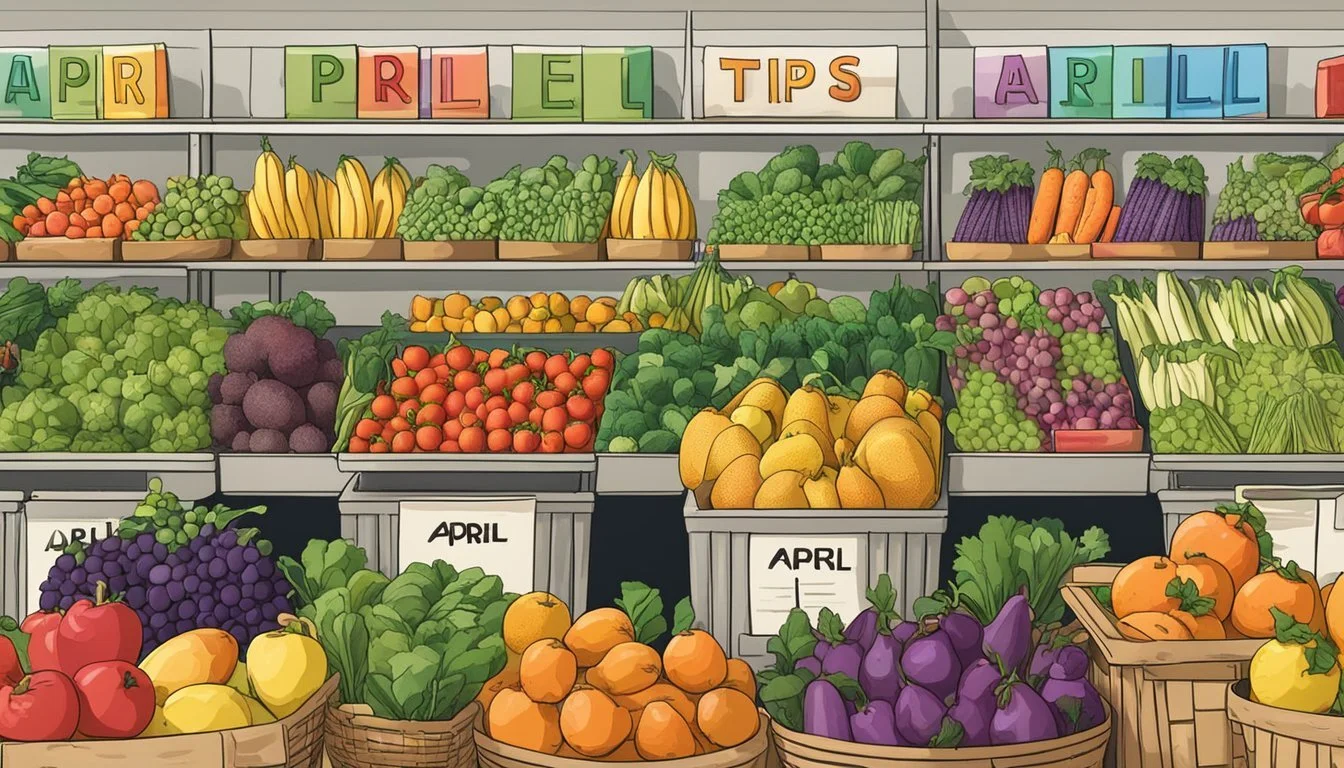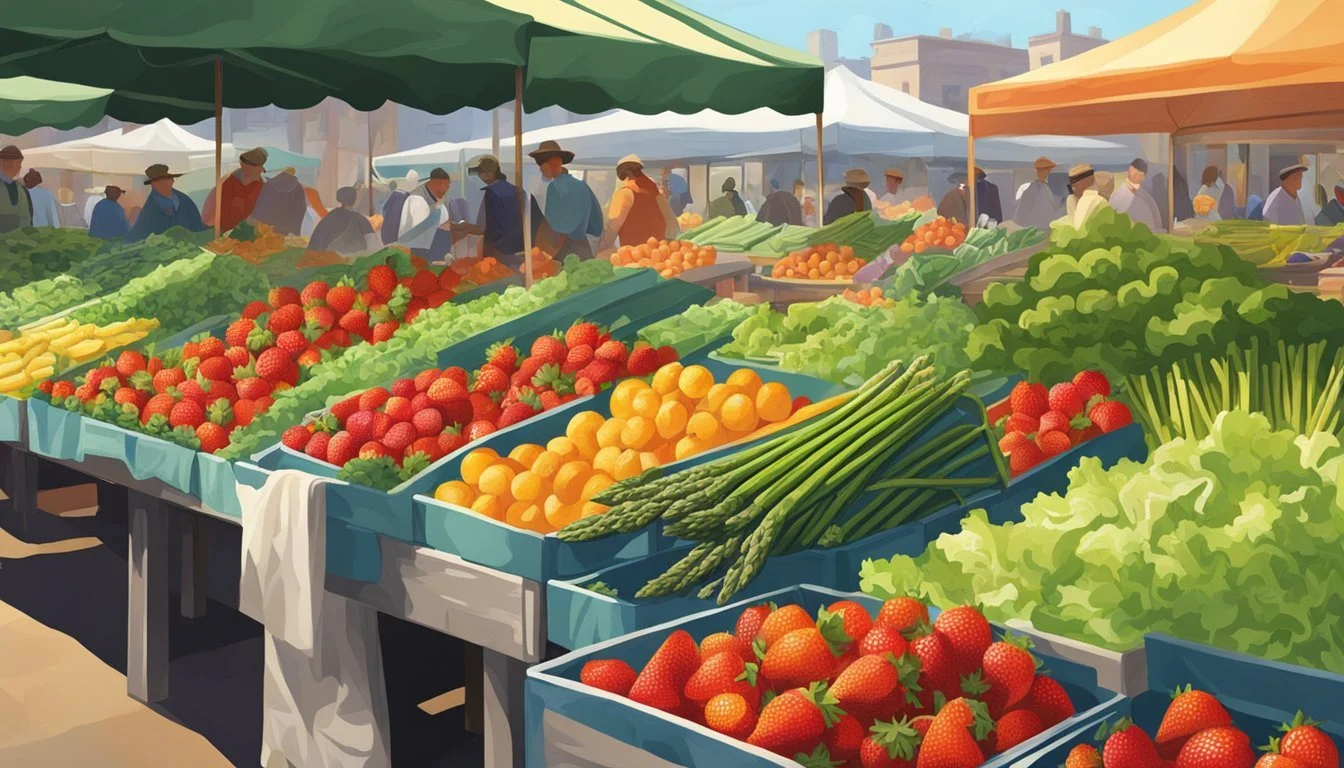Kansas Seasonal Fruit & Vegetables in April
A Guide to Fresh Produce
This Article is Part of our Kansas Seasonal Fruit & Veg Calendar
As the calendar turns to April in Kansas, the state's rich soil begins to yield a variety of fresh produce. April marks the start of a vibrant growing season, with the advent of spring bringing warmer temperatures ideal for farming. Kansas, primarily known for its expansive wheat fields, also boasts a diverse array of fruits and vegetables that come into season in the spring months. Consumers and local markets eagerly anticipate the arrival of fresh, locally-grown produce that not only supports the state's agricultural economy but also offers nutritional benefits and superior flavor.
Among the first crops to be harvested in Kansas are asparagus (What wine goes well with asparagus?) and beets, both of which are perfect for April's unpredictable weather—a mix of cool nights and gradually warming days. These vegetables are followed by other seasonal produce that starts to peak at the local farmers markets and in the gardens of those who appreciate the farm-to-table experience. Asparagus, known for its versatility in the kitchen, can be found fresh in April, while the earthy, sweet flavors of beets enrich the meals of Kansans with their vibrant colors and nutritious qualities.
Farmers across Kansas prepare for the season with sustainable practices that ensure produce is not only fresh but grown with attention to environmental impact. The state's focus on seasonal harvests not only enhances the quality of the food but also minimizes the carbon footprint associated with long-distance transportation of goods. The importance of seasonal produce is further underscored by the health and economic benefits it brings to the communities in Kansas, as it fosters a connection between the food on the plate and the land it came from.
Overview of Kansas Seasonal Produce
In April, Kansas's soil begins to yield a variety of fresh produce. The state's growers harvest a bounty of vegetables and a few early fruits that are indicative of spring's arrival. Patrons at local markets can expect to find spring staples, reflecting the agricultural prowess of the region.
Vegetables:
Arugula: This peppery green is perfect for fresh salads.
Asparagus: A spring favorite, characterized by its tender stalks.
Lettuce: Varieties such as romaine and butterhead are in abundance.
Mushrooms: While not a vegetable, these fungi are often grouped with vegetables and are plentiful.
Radish: Known for their crisp texture and peppery flavor.
Salad Greens: Including a mix of leafy varieties.
Spinach (What wine goes well with spinach?): Offers a rich source of iron and is versatile in the kitchen.
Scallions: Also known as green onions, they add a mild, crisp bite to dishes.
Produce availability in Kansas during April reflects the transition from winter to spring. With the soil starting to warm, it is a pivotal time for planting and early harvesting. Local markets might start to showcase plants and seedlings for those looking to start their own gardens.
Kansas seasonal produce is ideally purchased in its peak season to ensure maximum freshness, flavor, and nutritional value. Consumers in the state often take pride in supporting the local economy and the environment by choosing locally sourced fruits and vegetables.
Spring Harvest in Kansas
In April, the fertile plains of Kansas begin to yield a variety of fresh produce as the spring harvest season commences. Several vegetables become available, each celebrated for their flavor and nutritional value.
Here's a snapshot of the seasonal yield:
Asparagus: Among the first to appear, asparagus heralds spring's arrival in Kansas. Asparagus harvest typically spans from April through June, offering tender spears ideal for a variety of dishes.
Onions & Green Onions: Onion varieties, along with their milder counterpart, green onions, start to flourish. They serve as foundational flavors in many culinary creations.
Lettuce: Known for its crispness, lettuce emerges as a spring favorite, inviting a surge of fresh salads to the Kansan table.
Radishes: Providing a peppery kick, radishes are another early spring arrival. They are often enjoyed raw or as a bright addition to salads.
Peas: These pods bring sweetness and texture to meals, with the harvesting of peas signaling a progression into the warmer months.
Farmers in Kansas prepare for this season throughout the year, tending the soil and planning their crops to ensure optimal harvests. The spring harvest not only supports local agriculture but also provides an abundance of fresh options for consumers. As residents anticipate the new crop, markets and roadside stands begin to showcase the state's agricultural bounty. The vegetables available during this time are cherished for their freshness and are a testament to the state's agricultural expertise.
April's Featured Vegetables
Asparagus
April marks the beginning of asparagus season in Kansas. These tender green stalks are best when harvested through June, offering fresh flavors for a variety of dishes.
Root Vegetables
Carrots: Sow early in the month and enjoy these sweet, crunchy vegetables as a healthy snack or an addition to meals.
Radishes: Thinnings are crucial for these peppery bulbs which grow rapidly and can be harvested throughout April.
Beets: Plant in April for a harvest extending into autumn; their earthy taste complements both salads and cooked dishes.
Leafy Greens and Brassicas
Arugula: This peppery leaf is perfect for refreshing spring salads.
Spinach: A versatile green that thrives in the cooler spring temperatures.
Kale: Hardy and nutrient-rich, it's an excellent choice for early planting.
Broccoli (how long does broccoli last?): June through October marks its season, but early plantings begin in April.
Cauliflower: Similar to broccoli, starting now will yield a later harvest.
Other Seasonal Vegetables
Peas: Sweet and tender, they should be planted as soon as the soil can be worked.
Beans: While beans typically fare better in warmer months, certain cold-tolerant varieties can be started now.
Garlic: Though planted in the previous fall, April is when garlic begins to show vigorous growth.
Potatoes: Start these staple tubers early in the month for a bountiful harvest later on.
Rhubarb
Aside from its savory counterparts, rhubarb, a tangy vegetable often used in desserts, comes into season. The stalks are used for cooking, while the leaves should be avoided as they are toxic.
This selection anchors the April vegetable garden in Kansas with its range of tastes and nutritional benefits, fitting for both raw and cooked applications.
April's Featured Fruits
In Kansas, April marks the beginning of a fruitful period for local produce. Among the array of fruits that come into season, strawberries stand out as a favorite. These vibrant, juicy berries are not only a delight to the palate but also offer nutritional value with vitamins, fiber, and antioxidants.
Fruit Availability Notes Strawberries Starts in April High in vitamin C
As April ushers in warmer days, Kansas produce aisles and farmers' markets gradually fill with the year's first home-grown strawberries. These small red gems are versatile, and one can enjoy them fresh, in jellies and jams, or as a natural sweetener in various dishes.
Consumers can expect strawberries to be available throughout April, though the peak season extends into the following months, ensuring a sustained supply of fresh fruit. Kansas's agricultural sector takes pride in their strawberries, guaranteeing that the fruit meets high quality and freshness standards.
For those planning to incorporate local fruits into their meals, Kansas-grown strawberries provide a reliable and delectable option. Their availability in April is a reminder of the region's agricultural diversity and the rich bounty that the spring season brings.
Planting and Growing Tips
In Kansas, April marks a dynamic period in the gardening calendar. Growers should focus on planting cold-hardy vegetables, while also preparing for the warmer days ahead.
Cold-Hardy Vegetables: Lettuce, peas, and spinach thrive during the cool springs of Kansas. They are planted early in the month to take advantage of the remaining chilly weather.
Lettuce: Choose varieties like Butterhead and Loose Leaf, which can tolerate light frost.
Spinach: Prefers partial shade; maintain moist soil for optimal growth.
Peas: Require support for climbing; sow directly in the soil.
For Fruit Trees: Begin spray schedules as new growth appears. Newly planted trees should be watered consistently to establish roots.
Soil Preparation: Key amendments incorporate a balanced 10-10-10 fertilizer at the rate of 1 to 2 pounds per 100 square feet unless a soil test indicates otherwise.
Vegetables and Herbs Planting Tips Potatoes, Carrots, Onions Plant as early as soil can be worked. Beets, Radishes Thin early to avoid crowding. Broccoli, Cauliflower Start indoors, transplant late March or early April.
For salad crops like carrots, beets, and onions, direct seeding early in the month is advisable, followed by thinning to adequate spacings.
Additionally, gardeners in Kansas should look to establish perennial plants and herbs such as asparagus and rhubarb during this time, ensuring they are planted in well-draining soil to foster proper root development.
Regular monitoring of temperature forecasts remains critical, as unexpected frost can still occur. Gardeners must be prepared to protect tender plants with covers or delay planting sensitive varieties if frost is anticipated.
Farmers' Markets and Locally Grown Produce
Farmers' markets in Kansas serve as a hub for local farmers to present their freshest produce directly to the community. Amidst the myriad options, April heralds the arrival of specific fruits and vegetables that grow locally during this period. Shoppers can explore a variety of produce at these markets, offering a canvas of tastes and ingredients for those keen on crafting seasonal recipes or enjoying fresh, simple fare.
Patrons will find that, in April, markets typically overflow with leafy greens such as arugula, spinach, and various salad greens. These vegetables are not only rich in nutrients but also versatile for culinary use, from raw salads to cooked dishes. Radishes and scallions add a crisp, peppery note to any plate, while asparagus signals the beginning of its short but delectable season.
Here is a brief list of produce you might find at Kansas farmers' markets in April:
Arugula
Asparagus
Lettuce
Mushrooms
Radishes
Scallions
Spinach
Beyond vegetables, these markets occasionally offer local fruits, though the selection in April may be limited as many fruits are not yet in season. However, shoppers can usually procure farm-fresh eggs, which are a staple year-round, and depending on the market, locally sourced chicken can also be available, supporting a farm-to-table approach.
Patronizing farmers' markets enriches the local economy and nurtures the community bond. By choosing locally grown produce, patrons endorse sustainable agricultural practices and receive the benefit of peak freshness, all while engaging with the very people who cultivate their food.
Healthy Eating with Seasonal Produce
When considering healthy eating habits, incorporating seasonal fruits and vegetables is a crucial strategy. In Kansas, April's fresh bounty includes an array of produce that not only tastes better but also packs a nutritional punch due to peak ripeness.
Fruits:
For a sweet and tropical twist, pineapples reign supreme in April. High in vitamin C and bromelain, they offer a juicy burst of freshness and are excellent when juiced, grilled, or added to salads.
Vegetables:
Asparagus: A spring favorite, rich in fiber and vitamins A, C, and E.
Leafy Greens: Including arugula, lettuce, and spinach; these are versatile for salads and provide essential vitamins and minerals.
Radishes: With a peppery kick, they are a crunchy addition to dishes.
They can incorporate these vegetables into their meal plans by sautéing with a drizzle of olive oil, which contains healthy fats and enhances flavor. Grated Parmesan can be sprinkled on top for added taste and a calcium boost.
Seasonal Recipes:
Residents have various options to create nutritious meals. For instance, a spring vegetable lasagna, layered with thin slices of in-season veggies, whole-grain noodles, and a light cheese sauce could be a hearty main dish. It pairs perfectly with a mixed greens salad tossed in a red-wine vinaigrette.
Adopting a diet with produce like asparagus, leafy greens, and seasonal fruits during April in Kansas can contribute significantly to healthy eating practices. It supports not just personal well-being but also local agriculture, ensuring that the food on the table is as fresh and nutrient-dense as possible.
Storing and Preserving Tips
When handling the bounty of Kansas's April harvest, the proper storage and preservation of fruits and vegetables are key to maintaining their quality and extending their shelf life.
Root Vegetables: Carrots, beets, and radishes should be stored in a cool, dark place, ideally in a cellar or a refrigerator. They can be kept in perforated plastic bags to retain moisture but allow for air circulation. If greens are attached, they should be removed before storage to prevent moisture loss from the root.
Leafy Greens: Spinach and lettuce must be stored in the refrigerator. They should be washed, dried thoroughly, and wrapped in paper towels to absorb excess moisture, then placed in airtight containers or plastic bags.
Asparagus: Store upright in a glass of water, as one would with cut flowers, and cover them loosely with a plastic bag before refrigerating. This keeps the stalks hydrated and crisp.
Fruits: Strawberries and other berries should be refrigerated without washing to prevent mold formation. Wash them only right before consumption.
For preservation, blanching vegetables before freezing can extend their edible period. Blanching halts enzyme action that can cause loss of flavor, color, and texture. Freezing in airtight containers or vacuum-sealed bags can preserve most vegetables for up to 8-12 months and fruits for up to 6-9 months.
Canning is another option, especially for fruits, which can be preserved as jams or jellies. Vegetables can be pickled or canned in brine. One should always follow safe canning guidelines to prevent the growth of bacteria such as Clostridium botulinum.
Remember, all produce has an optimal storage method that preserves taste and nutritional value. If uncertain, consumers should consult reliable resources for specific instructions tailored to each type of produce.
Seasonal Recipes and Preparation Ideas
In Kansas, the month of April brings a variety of fresh produce to the table, with ingredients ideal for vibrant recipes. Asparagus is a standout vegetable that can easily be incorporated into a variety of dishes.
Steak & Asparagus: A simple, yet flavorful idea is to grill or roast asparagus with a drizzle of olive oil and serve it alongside a juicy steak. The combination creates a balanced meal celebrating both Kansas produce and traditional American cuisine.
For a creative twist on pies, incorporating seasonal vegetables can result in a delightful dish.
Spring Vegetable Pie: Asparagus, along with carrots, can be baked into savory pies, delivering a heartwarming meal that is both comforting and nutritious.
Pizza enthusiasts can also enjoy the freshness of April produce.
Seasonal Veggie Pizza: Embellish your pizza with thinly sliced asparagus, radishes, and sprouts to add a crunch and peppery flavor, complementing the melted cheese and tangy sauce.
Salads are an excellent way to showcase a variety of fresh ingredients.
Salad Ingredients Preparation Asparagus Blanched Strawberries Sliced Mixed Greens Fresh Radishes Thinly sliced
One can dress such salads with a simple vinaigrette to enhance the natural flavors of the ingredients. They serve as a light, refreshing starter or as a wholesome meal on their own.
Remember, the best recipes are often those that let the natural flavors of high-quality, seasonal ingredients shine. Kansas's April bounty allows for culinary creativity while still keeping preparations straightforward and enjoyable.
Conclusion
Eating seasonally is a beneficial practice, and Kansas in April offers an array of fresh, local produce. The availability of local produce supports sustainability through reduced transport emissions and bolsters community agriculture.
Vegetables: Consumers can find fresh asparagus, which is typically harvested from April to June. Incorporating these vegetables into one's diet not only ensures peak flavor but also supports local Kansas farmers.
Local Connections: Purchasing local produce fosters a stronger community connection. Farmers’ markets become vibrant gathering places where shoppers can interact with the growers directly, creating a trustful food source network.
Sustainability: Sustainability is reinforced by choosing local, in-season foods. Lower transportation requirements mean a smaller carbon footprint, and produce that doesn't travel long distances retains more nutrients.
Health Benefits: Kansas-grown produce in April is often harvested at its nutritional peak, providing maximum health benefits to the consumer. Fresh asparagus, among other vegetables, offers vitamins A, C, E, and K.
Economic Impact: By buying from local Kansas producers, consumers help stimulate the local economy, ensuring that their purchasing power positively impacts their immediate environment.
By focusing on these factors, Kansas residents can contribute to a healthier and more sustainable food system while enjoying the bounty of their local produce in April.

